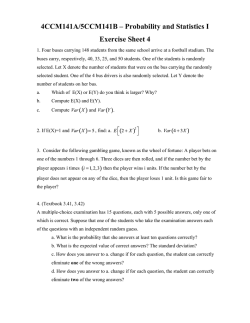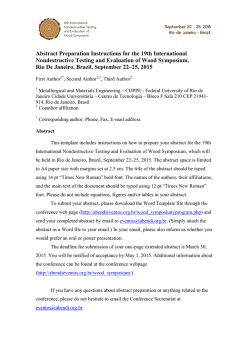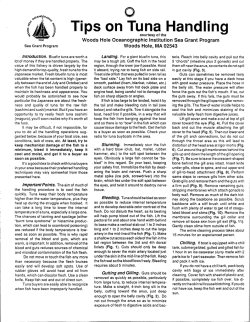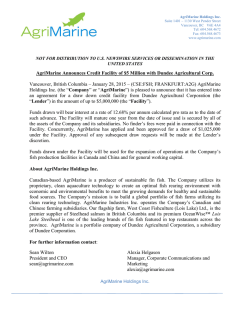
DIET OF ASTYANAX FASCIATUS AND CYPHOCHARAX
Dahlia - Rev. Asoc. Colomb. Ictiol. (2005) 8: 3-7 DIET OF ASTYANAX FASCIATUS AND CYPHOCHARAX MAGDALENAE (PISCES: CHARACIFORMES), IN THE BETANIA RESERVOIR, UPPER PART OF THE RIO MAGDALENA SYSTEM, COLOMBIA It Plutarco Cala D ep artamento de Biologfa, Universidad N acion al de Colombia, Bogota, D.C. plutarco_ cala@h otmail.c om Abstract The principal food items of 98 adult specimens of A. [osciotus are plant matter (63% TW and 68%FO). and chir onomid larvae (3%PT, 27% FO) . followed by For micidae. detritus, fish scales (characid) . and fish larvae. Summing up. this means a 63% TW and 72%FO plant mat eri al. and 28% TW and 94%FO mid ges (Table I). The diet of this omni vorous fish is very simil ar t o its congener A. bimaculatus . which consumes prin cipally plant matter and midges. The principal food items found in the stom ach contents of 50 adult specimens of C. magdafenae w ere detritus and phyt oplankt on. The taxonom ic qualitat ive analysis showe d the presence of five classes of phytoplankton , classified in J0 orders, 13 families with 27 genera. Th e zooplankton w as represented by Monogononta, order Ploirna and the family Brachionid ae with two genera (Table 2). The three principal categor ies were the classes Baclllariophiceae, Chlorophiceae and Cyanophyceae (Phot o bacteri a). Thus . C. magdaJenae may be considered rather detritivorous. nearly algivorous. The fish consumes sediment (det rit us) in the first place in order to swallow the nutritious associat ed food it ems. Th e stomach contents of 10more specimens show ed an average percemage of24 .6% organic mat erial and 75.2% of inorganic matter (Table 3) . It seem sthe alimentary diet of C. magdalenae is similar to th at of Oreochromis niloticus. This could be a competitive factor of the exotic cichlid over the native species in the Magdalena River system. since both species occupy mostly the same habitats, Key words: diet A. (asciatus and C. magdalenae. Magdalena River system. Resumen Los pr incipaJes it ems alimentarios de 98 peces adultos de A. [asciotus son material veget al (63% TW; 68%FO) Y larvas de Chiro no mid ae (3%TW; 27%FO). seguidos por Forrn icidae. detrito, escamas de peces (characide). y larvas de peces. Resumiendo, esto significa un 63% TW Y 72%FO d e material vegetal. cont ra 28%TW Y 94%FO de restos aninm ales (Tabla I). La dieta de este pez omnivoro es muy similar a la de su congenere A. bimaculatus, la cual consum e prin cip almente material veget al y dlpteros. EI contenido estomacal de 50 espedmes adultos de C. magdalenae fuedetritus y fito plancto n. EI analisis taxon6mi co cualitati vo mo str 6 la presencia de 5 c1ases de fitoplancton, c1asifJcado en 10 6rd enes, 13 familias con 27 generos, El zooplancton estuvo repr esentado por Mono gononta. orden Ploima y la familia Brachionidae con dos genero (Tabla 2). Las tres catego ri as prin cipales fuer on las clases Bacillar iophic eae. Chlorophiceae y Cyanophyceae (Photobact eria). Asi, C. magdalenae puede ser considerad a det ritivora, mas cer canament e algivo ra. EI pez consum e sedim ento (det rit us) y de ahi ext rae los nutrientes asociados en el. E\ contenid o est omacal de 10 espedmenes rnostro un porcentage promedio de 24% de material or ganico y 75.2% de materi a lnorganica (Table 3). Aparentente la dieta aliment icia de C. magdalenae es muy similar a la de Oreochromis niloticus. Esto podrfa ser un factor competitivo del exot ica dclido sobre la especie nativa en el sistema del Rio Magdalena, pues ambas especies se encuentran dlstribuidas general mente en los mismos habitats . Palabras clave: dieta A. [asciatus y C. magdalenae. Rio Magdalena. 3 Dahlia. No.8. 200 5 Table I. Food items taken byA. [osaatu « inthe Betania Reservoir, expressed as percentage ofFrequencyof occurrence (% FO) and totalweight (% TW). PMTW = plant material totalweight, A RTW = Animal rests totalweight. n = number offishes, SL = Standard length (mm), L = larvae, N = nymph. A = adult. he ms land Detritus Plantmatter Seeds Animaln;m Filblarvae Sca lel Coleoptera (A) Chironomidae (t) Formicidae(A) Ce r.ltopogonidaE(L) Hemipter.l (N) Ephemeropclr.1 (N) Ostracoda (A) Cyclopidae PMTW ARTW N Mean Sl Sl interval februa ry %TW %fO 3 8 65 8 II 69 April %TW %FO 44 54 <I 25 88 6 May %TW %10 2 94 18 19 1 31 38 <I I II 21 13 76 (42.113) 54 3 8 85 (71. 103) 13 I <I <I <I <I 95 4 33 69 (50.93) Introduction This paper discusses the aspects of the diet and the trophic level function oftwo species of chara cifonn fishes -Sardine Red/yellow tailed , Astya nax fasciatus (Characidae), and Madre de Bo cahico, Cyphocharax magdalenae (Curimatidae) - in the Betania Reservoir, upper part of the Rio Magdalena. Study area and methods The Betania Reserv oir has an area of 7,400 ha, constructed at the junction of the Rio Yaguara with the Magdalena (02°41' north ern latitude and 75°26' Western), 35 km south east ofNeiva city, at 560 m altitud e, with a crest high of9 8 m, a vo lume of 2,000 minions of cubic meters, and a flow of473 m3/s atthe dike. For further informa tion on the environment and fish community see Cala (1995). 4 6 79 ~'J u ly %TW 28 I 39 %FO 57 9 43 15 October %TW %FO 2 15 9 55 16 59 20 60 II <I I <I 3 10 <I <I <I <I <I 59 25 15 80 (68·89) 27 <I 41 7 40 20 <I 7 7 <I <I 5 14 33 <I D 2 42 <I 64 17 5 9 6 3 33 12 28 72 7 78 (64-86) 43 <I <I 16 82 22 69 (42·107) December %TW %10 5 Total %TW <I 9 63 <I 5 1 2 <I 3 10 <I <I <I <I <I 63 28 98 74 (42·113) %10 I 10 68 4 16 5 20 5 I1 10 I I 1 I 6 n 94 The fishes were captured, mainly with cast nets of small mesh size, in the Yagura River arm whe re the two species were more common since this area is less deep than the Magdalena River arm. Six collections separated by a 45-60-day interval were made in 1991 (April-December). Standard length (SL) and total weight (TW) of fresh fish materi al was determined . Then, their stomachs were removed and fixed in 5% formalin for later study at the la boratory, Frequency of occurrence (FO) and gravimetric (TW) methods were used in the analysis of stomach content (WindeII & Boewn 1978). Representative specimens from the studied area were deposited at the Fish Divi sion of the Instituto de Ciencias Naturales-Mu seo de Historia Natural (ICN-MHN), Universi dad Nacional de Colombia, Bogota D.C. The identifi cation of plankton and invertebrate organisms was aided by usiug general keys (e.g. Smith 1950, Gonza lez 1988, Pennak 1989). The classification of phytoplankton at higher levels of the family was made in accordance with Rey nolds (1984). The percentage of organic and inorganic material in the alimentary diet was de Table 2. Food ite ms (taxa) taken by C. magda/enae. in the Table 3. Pe rce ntage of organic and inorganic matte r found in the stomach contents o f 10 sped mens o fC magdalen ae Inthe Be tania Re servo ir. Yaguara River arm , Betania Reservoir. O M : orgaruc matter. Clall Order Oedo!" oia l., lignemelalfl family Oedogonimae l i~ nemtta (f.iI (I Oe> miliaCM 1M: ino rganic matt e r. OerlOo / ll/j/m l ignefllJ l1icrolpora ~Imariu m f r3l1tV/ll'l f SraurilSlfum f13l1roUrJmuJ Sce/lerff!JmUI Phetobartena (Cyanophycoae) Ulvale> Icnilogoni.,m Nosloc.l" NOllocacm Eugl!llophyce. e Eugl,", I'l Bacillariopny teae (O;atomw) Cenlrales Penn. ln f,.firmn \cbilogonium Oscilla tori. ,e.e A" aikl,"a [, lIIgby. NOdulari. Oscillalori. Eugl' nm .. r",,!lelomollal ~ e lo li r aceae 11e10II", Oi.tom. " ae N. viculaceae f/dgili ri, [,mbell. Karimi, frvrtrJliJ Pinllufaria Niclchia G,rorigm. Ephilemial' l Acb. ntha les O,oo pbycm HOIlllgononta Pillima Ephitemiacm Acllaml..ceae S.rirell. f phiwna [O«Ollei1 Peridi,..ceae 1'Prirfinium Bra'ruonida e t'n te/Ii flfina Or!. nic ma leri. 1 InorganKma tter termined by burning the stomach contents at 600 °C (Gonzalez 1988). See Cala and Bernal (1997) for further details on methodology. Results and discussion Astyanax fa sciatus (Cuvier, 1819). 98 speci mens captured over a year period were examined in order to study the stomach content. The speci mens were distributed evenly over a range of 42 to 113 mm SL (mean 74). Mean total length 96 mm, and maximum total length 130 mm, alt hough Dahl (197 1) mentioned 170 mm, and Lima et at. (2003) reported 100 rom TL. This species belong to the 13most abundant species of ~' filii Tl (em) 16.4 15.5 16.1 15.1 14.5 16.0 13.2 [17 14.6 [5.0 TW (g) 70.0 58.0 58.0 50.0 42.0 60.0 31.5 37 .6 45.0 51.0 Date May 14 Oct. 8 Oct. 10 Dec. 13 %OH %IH 40.8 7.0 54.0 25.0 26.0 38.3 14.5 12.2 18.6 9.8 591 93.0 46.0 75.0 74.0 61.7 85.5 87.5 81 A 90.2 a total of 33 species capture d in the Reservoir (Cala 1995). It is distributed in most freshwater basins from Mexico to Argentina. Its principal food items are plant matter (63%TW and 68%FO) and chironomid larvae (3%TW, 27%FO), followed by Formicidae, detritus, fish scales (characid), and fish larvae. Summing up, this means a 63%TW and 72%FO plant material, and 28%TW and 94%FO anima l rests (Table 1). The diet of this omniv orous fish is very similar to its congener A. bimaculatus , their two principal food items bein g plant matter and midges (Cala 1997). The examination of a sample of 71 adult mature specimens of A. fascia tus deviated significantly from a I: I ratio, the male/female relationship being 1:12. The total mean length of 11 adult fe males and 4 males was 102 and 92 mrn, with an average weight of 14.2 and 9.6 g, respectively. It seems like females reach a greater size than males, which could be a selective factor of these indivi duals concerning the mesh size of the cast nets used in the capture of the population sample. Thus, females of this species reach larger sizes than females reported in other Astyan ax species e. g. A. auricaudatus, the mean standard length of females was 36.6 mm versus 43.3 for males (Ro man-Valencia & Ruiz-C. 2005). 5 th 71 mature Aifasciatus captured on 13 Decem ber were in stage prior to the spaw ning, or Stage III with mature oocytes and spermatozoa (Cala 1996, 1997). It may be assumed that the repro duction strategy ofthis fish speci es is that it has a regeneration time of 12 months and it spawns an nually during the first month of the rainy season (February-May). Barbieri et at. (1996, cited by Roman-Valencia & Rui z- C. in this publi cation) reported the spawning time of A.fa sciatus, in the Represa do Lobo , Sao Paulo, between October and December. This reproduction strategy has being reported by CalaandBlanco (1974) for A. bimaculatus , and by Taphorn (1992) for six other specie s from the Rio Apure in Venezuela, which may be the general patteru of reproduction strategy of Astyanax spp. However, Roman-Valencia and Ruiz-C. (2005 in this publication), suggest that A. aurocaudatus spawns during the rainy (April-May, Septem ber-October) aud dry seasons (January-February), aud Mora et al. (1997) mentioned that in the Reser voir of Arenal in Costa Rica, A. fasciatus spawns during the eutire year, with a maximum between June to September. These two last couclusions (Ro man-Valencia and Ruiz-C, 2005, Mora et al. 1997) seem to need further observations , since they are not based on conclusive studies. Cyphocharax magdalenae (Steindachner, 1878). Previously known as Curimatus(a) mag dalenae until it was included in the genu s Cypho eharax (Vari 1992). Asample of 157 adult «11.5 em TL) C. magdalenae takeu between April and Dec emb er 1991 was composed of Tl (50.7% ) mature male s and 75 (49.3 %) mature females. The numbers do not deviate significantly from a 1:1 ratio . All fish longer than 9 em SL (I 1.5 em TL) wa s mature (will spawn during the next re production period). Maximum total length 17.2 cm(n .7 g). Dahl (1971) aud Vari (2003) mentio ned20 and 15.5 em SL, respe ctivel y. C. magdale nae inhabits mainly lacu strin e waters (cienagas) 6 of the lower parts of Magdalena and Atrato River basins, rivers of Pacific versant of Panama , and southwestern Costa Rica. 50 specimens of the Madre de Bocachico were exa mined in order to analyze the composition of the diet, distributed over a range of 90 to 140 mm SL (mean 122). The stomach content ofanother 10 in dividuals, 10.2 to 13 em SL (mean 11.85), were analyzed to establish the percentage oforganic and iuorgarric material ofthe alimentary diet. The principal food items are detritus and phyto plankton. The taxonomic qualitative anal ysis showed the pres ence of fiv e classes of phyto plankton, classifi ed in 10 orders, 13 families with 27 genera. The zooplankton was represented by Mono gononta, order Ploima and the fam ily Bra chionidae with two geuera (Table 2). Th e three principal categories were the classes Bacillariop hiceae, Chlorophiceae and Cyanophyceae (Pho tobacteria) . C. magdalenae may be con sidered rather detriti vorous, nearl y algivorous. The fish consumes se diment (detritus) in order to swallow the nutritio nous food item s in it. The stoma ch cont ents of 10 specimens showed an average perceutage of 24.6% organic material and 75.2% inorganic matter, which explains the large quantity of sedi ments in the fish stomac hs. The perceutage of or ganic material iu comparison with inorganic mat ter in the stomach contents was hi gher than what wa s fouud in Oreochromis niloticus from the same water body (I.4 % and 98 .6%, respecti vely) . This mean s that the diet of C. magdalenae in terms of protein aud carbohydrates average percentage should be richer thau the 0. niloticus which was determined in 7.5% and 0.85%, res pectively (Cala & Bernal 1997). Thus, it seems that the alimentary diet of C. mag dalenae is similar to that ofthe 0. niloticus (Cala & Bernal 1997). This could be a competitive fac tor of the exotic cichlid with a native species iu the Magdalena Riv er system, since both species occup y mostly the same habitats. Be rtaco.C , Mor eira & P.H .F. Lucinda. 2003 . Genera incerta sedis in Characidae . 106-169 . In R.E. Reis, S.O . Kullander & CJ Ferraris, Jr (O rga nize rs) . Chec k list of the fre sh water fishes of South a nd C entral America. EDIPUCRS , Porto Alegre, Brazil. 742 p. Acknowledgements I am grateful to the biologist Gilberto Mora for aid in the analysis of stomach contents. To Anni ka Cala for correcting my English. This study was carried out under contract 268/90 Universi dad Nacional de Colombia-Central Hidroelectri ca de Betania. References Cala , P. 1995 . Trophi c level o fth e most abundant fishe s of th e Betania Res ervo ir, upper Rio Magdal en a , Colombia. Mem. Symposium Fish. Ecology in Latin America, Austin Texas ,june 1993. Acta BioI. Venez.16 (1):47-53 . C ala, P. 1996 . Cyclic histomorphological changes in the ova ry of the catfish capaz , Pime(odus grosskopfr ; (Pime lod idae, Siluriformes), in th e upper part o f the Rio Magdalena. Dahlia (Re vist a Asoc. Colomb. lctiol.) I : 7- 13. Cala, P. 1997 . Espermatogenesis y cicio anual reproductive del capaz, Pim e/odus grosskapfri (Pisce s: Pimelodidae), en el alto Rio Magd alen a, Colombia. Cald asia 19 ( 1-2): 45-53 . Cala , P. & G. Bernal. 1997. Ecologfa y adaptaciones de la Tllapia nilotica (Ore chromis niloticus) en arnbi entes naturales - caso Emb alse de Bet ania y Cienaga de Chilloa , sistema del RIO Magdalena, Colombia. Dahlia (Re vist aAsoc. Colomb . !ctiol.) 2: 3-29 Dahl , G. 1971. Los peces del norte de Colombia. INDERENA Bogota. r ' Mora, j .M, P. Cabre ra & W. Alvar ado -Bogantes.1997. C recimiento y rnaduracion sexual de Astyanax fasciatus (Pisces : Characidae ) en el embalse Arenal , Guanacaste, Costa Rica . Re v BioI. Trop . 45 : 855-859. Pennak, R.W. 1989. Fresh-water invertebrates of th e United Sates: Protozoa to Mollusca. 3'd. ed ., John Wiley & Sons, New York. xvi+ 628 p. Reinolds, CS. 1984. Th e eco logy of freshwater phytoplankton. Cam bridges Studies in Ecology. Cambridge University Press, Cambridge. 383p. Roman-Valencia & R.I. Ruiz-C . 2005 . On the ecology of Astyonax aurocaudatus (Teleostei: Characidae) from the upper part of the Rio Cau ca , Colombia. Dahlia (Rev. Asoc. Col omb . Ictiol.) 8 : 9-17. Smith, G. 1950 . Th e fresh -water algae of th e United States. Second edition. McGraw Hill, New York. Taph orn, DC 1992. The characiforrn fishes of the Apure River drainage, Ve ne z ue la . Mon ograff as Cientificas del Museo de Ciencias Naturales UNELLEZ - Guanare , Estado Portuguesa, Vene zuela.537 pp. Vari, R.P. 1992. Syst ematics of th e Neotropical characifo r m genus Cyphocharax Fowler (Pisces: Ostariophysi). Smithson. Contrib. Zool. 529: i-iv+ 1-137. Gonzalez , 1988 . EI plancton de las aguas continentales . Secretarfa Gen eral de la Organizacion de Estados Americanos (O EA). Programa regional de desarrollo cientifico y tecnologico. Washington. 130 p. Vari, R. 2003 . Family Curimatidae (To ot hless c harac ifo rrns). 51-64. In R.E. Reis, S.O. Kullander & Cj Ferraris , jr (O rganize rs) . Check list of the freshwater fishes of South and Central Ameri ca . EDIPUCRS, Porto Alegre. 742 p. Lima , F.CT. , L.R. Malaba rba, P:A Buckup, J.F. Pezzi da Silva, R.P. Va r i, A. Harold , R, Benine, O .T. Oyakawa, CS. Pavanelli, N .A. Nenezes , CAS . Lucena, M.CS.L. Malabarba, Z.M .S. Lucena, R.E. Reis, F.Langeani, L. Cassati , VA Windell,j .T.& S.H. Bowen. 1978 . Methods for study of fish diet. In T. Bagenal (e d .) Methods for assess ment of fish production in fresh waters . pp . 219-266. IBP Handbook No. 3 (3'd. ed .), Blackwell Sci. Publ. , Oxford. 365 p. 7
© Copyright 2025




